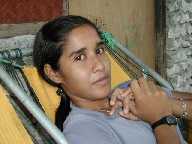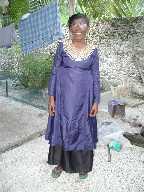 |
 |
 |
| Maldivian Women at the Crossroads |
|
Somewhere amongst the distant memories of Maldivian history, women were on top.
But since then it has been a steady downhill slide for them till almost the 1990s,
when the Maldives adopted a policy of gender equity.
The earliest writers on Maldives such as Sulaiman the Merchant (9th century) and Al Masudi (10th century)
described a matriarchal society ruled by queens.
But soon this started changing, perhaps under the influence of visiting traders from strongly male dominated societies.
Thus, by the 12th century Al Idrisi described a society where a male chief ruled over the islands,
while his wife still wielded some power.
|
|

A Maldivian girl relaxes on a 'joli'. What
does the future hold for her?
The struggle for supremacy among the sexes appears to have come to a head around the reign of Sultana Rehendhi Khadeeja. She succeeded her father to the throne. But twice,
ambitious husbands deposed her with the help of a male dominated nobility. Both times she managed to regain her throne and ultimately passed it on to her sister. Sadly, this was to be the last woman ruler the Maldives would ever
see. |
|

The traditional dress that Maldivian women managed
to preserve till the turn of the twenty first
century.
In earlier times dress codes and standards of behavior appear to have been similar for both sexes. Ibn Batuta (14th Century) described women’s attire that left the upper body un-covered. Significantly,
he also describes his own attempts to have the women covered. Obviously, more people like him
visited the Maldivian shores later and continued his work, for
by the 18th century the Maldivian society had developed the typical double standards that
all male dominated societies apply to the genders.
This changed societal attitude was preserved for posterity in the writings of Hassan Tajuddin in his magnum opus, the
Taarikh. The society of his time appears to be quite lenient towards the sexual promiscuity of its male royalty. Thus, despite all the unsavory details we know about Kalaafaanu’s love life (the Writings of Pyrard de Laval), Tajuddin had
nothing but words of praise for the king. But every time he saw a woman in a position of power, he donned a different pair of spectacles and promptly went on to dissect her character. One can clearly see the glee with which he went on assassinating the characters of Kamba Aisha (widow of King Ali VI) and Maryam Kambaa (widow of Ibrahim
Iskandharu).
Despite this changed societal attitude, Maldivian women managed to preserve some modicum of their ancient glory until the modern times. Thus they still enjoy more rights than most of their
sisters in Asia.
|
|

President Gayoom appoints the first woman atoll
chief.
Women’s Position Today
At the political level, the Government is committed to give equal rights to women. To push this policy forward it appointed a separate ministry for women in 1993. All islands have women’s development committees that work to bring women to the political mainstream. The Family Law, which came into effect last year, gave much needed rights to women. Recently President Gayoom appointed the first woman atoll chief.
Despite this progress, women in Maldives have still a lot of hurdles to cross. The most prominent of which are the double standards applied to the sexes. Under the influence of extremists, women are being gradually ‘coerced’ into wearing Arabic-style dresses, while there is no such coercion for men.
Maldivian society still continues to think that a woman’s place is in the house. As a result of this not many women are active in politics or public life. Even those in government
occupy mostly the lowest rungs. Interestingly, there are two professions that have more females than males –nursing and teaching. The reason for this appears to be that society sees these professions as extensions of a woman’s role at home. Thus teaching is an extension of looking after children, and nursing is an extension of caring for the elderly and the ill at home. Not surprisingly, in both the professions, there are more males in decision-making positions –most doctors and principals are males.
The Maldivian woman is once again at the crossroads. On one side modernity beckons. On the other, reactionary forces hold
her back. Where does she go from here?
|
 |
|
|




